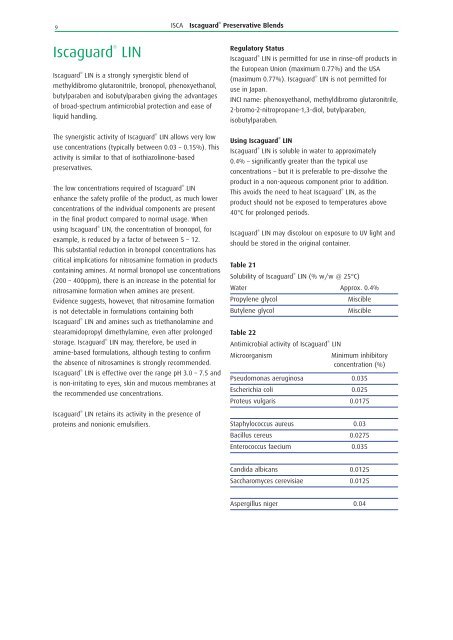ISCAGUARD ® Preservatives for Personal Care - ISCA UK Ltd
ISCAGUARD ® Preservatives for Personal Care - ISCA UK Ltd
ISCAGUARD ® Preservatives for Personal Care - ISCA UK Ltd
Create successful ePaper yourself
Turn your PDF publications into a flip-book with our unique Google optimized e-Paper software.
9<br />
Iscaguard <strong>®</strong><br />
LIN<br />
Iscaguard <strong>®</strong><br />
LIN is a strongly synergistic blend of<br />
methyldibromo glutaronitrile, bronopol, phenoxyethanol,<br />
butylparaben and isobutylparaben giving the advantages<br />
of broad-spectrum antimicrobial protection and ease of<br />
liquid handling.<br />
The synergistic activity of Iscaguard <strong>®</strong><br />
LIN allows very low<br />
use concentrations (typically between 0.03 – 0.15%). This<br />
activity is similar to that of isothiazolinone-based<br />
preservatives.<br />
The low concentrations required of Iscaguard <strong>®</strong><br />
LIN<br />
enhance the safety profile of the product, as much lower<br />
concentrations of the individual components are present<br />
in the final product compared to normal usage. When<br />
using Iscaguard <strong>®</strong><br />
LIN, the concentration of bronopol, <strong>for</strong><br />
example, is reduced by a factor of between 5 – 12.<br />
This substantial reduction in bronopol concentrations has<br />
critical implications <strong>for</strong> nitrosamine <strong>for</strong>mation in products<br />
containing amines. At normal bronopol use concentrations<br />
(200 – 400ppm), there is an increase in the potential <strong>for</strong><br />
nitrosamine <strong>for</strong>mation when amines are present.<br />
Evidence suggests, however, that nitrosamine <strong>for</strong>mation<br />
is not detectable in <strong>for</strong>mulations containing both<br />
Iscaguard <strong>®</strong><br />
LIN and amines such as triethanolamine and<br />
stearamidopropyl dimethylamine, even after prolonged<br />
storage. Iscaguard <strong>®</strong><br />
LIN may, there<strong>for</strong>e, be used in<br />
amine-based <strong>for</strong>mulations, although testing to confirm<br />
the absence of nitrosamines is strongly recommended.<br />
Iscaguard <strong>®</strong><br />
LIN is effective over the range pH 3.0 – 7.5 and<br />
is non-irritating to eyes, skin and mucous membranes at<br />
the recommended use concentrations.<br />
Iscaguard <strong>®</strong><br />
LIN retains its activity in the presence of<br />
proteins and nonionic emulsifiers.<br />
<strong>ISCA</strong> Iscaguard <strong>®</strong><br />
Preservative Blends<br />
Regulatory Status<br />
Iscaguard <strong>®</strong><br />
LIN is permitted <strong>for</strong> use in rinse-off products in<br />
the European Union (maximum 0.77%) and the USA<br />
(maximum 0.77%). Iscaguard <strong>®</strong><br />
LIN is not permitted <strong>for</strong><br />
use in Japan.<br />
INCI name: phenoxyethanol, methyldibromo glutaronitrile,<br />
2-bromo-2-nitropropane-1,3-diol, butylparaben,<br />
isobutylparaben.<br />
Using Iscaguard <strong>®</strong><br />
LIN<br />
Iscaguard <strong>®</strong><br />
LIN is soluble in water to approximately<br />
0.4% – significantly greater than the typical use<br />
concentrations – but it is preferable to pre-dissolve the<br />
product in a non-aqueous component prior to addition.<br />
This avoids the need to heat Iscaguard <strong>®</strong><br />
LIN, as the<br />
product should not be exposed to temperatures above<br />
40°C <strong>for</strong> prolonged periods.<br />
Iscaguard <strong>®</strong><br />
LIN may discolour on exposure to UV light and<br />
should be stored in the original container.<br />
Table 21<br />
Solubility of Iscaguard <strong>®</strong><br />
LIN (% w/w @ 25°C)<br />
Water Approx. 0.4%<br />
Propylene glycol Miscible<br />
Butylene glycol Miscible<br />
Table 22<br />
Antimicrobial activity of Iscaguard <strong>®</strong><br />
LIN<br />
Microorganism Minimum inhibitory<br />
concentration (%)<br />
Pseudomonas aeruginosa 0.035<br />
Escherichia coli 0.025<br />
Proteus vulgaris 0.0175<br />
Staphylococcus aureus 0.03<br />
Bacillus cereus 0.0275<br />
Enterococcus faecium 0.035<br />
Candida albicans 0.0125<br />
Saccharomyces cerevisiae 0.0125<br />
Aspergillus niger 0.04


